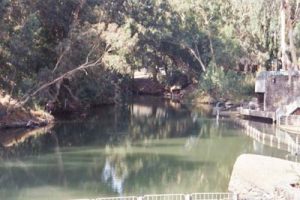by Pastor Ed Visser
…the word of God came to John son of Zechariah in the desert. He went into all the country around the Jordan, preaching a baptism of repentance for the forgiveness of sins. – Luke 3:2-3
 John the Baptist is an interesting character. A cousin of Jesus from a priestly family, John spent his time in the desert rather than the Temple. When he came out of the desert, he looked like Elijah — Jesus would later say that he was the “Elijah to come” — and he began baptizing people in the Jordan River.
John the Baptist is an interesting character. A cousin of Jesus from a priestly family, John spent his time in the desert rather than the Temple. When he came out of the desert, he looked like Elijah — Jesus would later say that he was the “Elijah to come” — and he began baptizing people in the Jordan River.
A Jewish practice, baptism was by self-immersion, which explains why the earliest picture of John baptizing Jesus (from catacombs in 2nd century) shows John standing on the bank, extending a hand to help Jesus out of the water. John’s baptism is described as a ritual immersion for ‘forgiveness of sins,’ a term related to Jubilee. The Jubilee year begins on Yom Kippur, looking forward to God sending the Redeemer after he forgave their national sins. John is calling Israel to take a step of repentance & obedience, believing the Redeemer to be at hand.
When Jesus appears on the scene, John senses the time has come. But as the months go by, John begins to have some questions — especially when he is thrown into prison by Herod Antipas.
When John heard in prison what Christ was doing, he sent his disciples to ask him,“Are you the one who was to come, or should we expect someone else?” Matthew 11:2-3
John’s confusion comes from his expectation that Jesus would begin baptizing not only with the Spirit, but with fire — the fire of judgment on Israel’s enemies. But John wasn’t seeing the fire! Jesus later tells his disciples that there would be two comings: his first would offer salvation; his second would bring the fire of judgment on those who deserved it (as well as final vindication for his people, eternally). John died, however, without the full explanation.
 The New Testament places John’s ministry in the desert in the regions of the Jordan. As we toured Israel, we discussed the idea that the term for desert (midbar) could simply mean “unsettled places” where flocks could graze. There are many such places around the Jordan, especially north of the Sea of Galilee. Dr. Steven Notley, one of our guides, suggested that it was likely John spent more of his time at the northern Jordan, immersing where the river is “pure” (south of Galilee, several other rivers join with the Jordan, making it apparently “impure” by rabbinic standards). Later, Jesus would meet crowds who were like “sheep without a shepherd” in this area. These may have been John’s disciples, looking for a new leader (Jesus!).
The New Testament places John’s ministry in the desert in the regions of the Jordan. As we toured Israel, we discussed the idea that the term for desert (midbar) could simply mean “unsettled places” where flocks could graze. There are many such places around the Jordan, especially north of the Sea of Galilee. Dr. Steven Notley, one of our guides, suggested that it was likely John spent more of his time at the northern Jordan, immersing where the river is “pure” (south of Galilee, several other rivers join with the Jordan, making it apparently “impure” by rabbinic standards). Later, Jesus would meet crowds who were like “sheep without a shepherd” in this area. These may have been John’s disciples, looking for a new leader (Jesus!).

